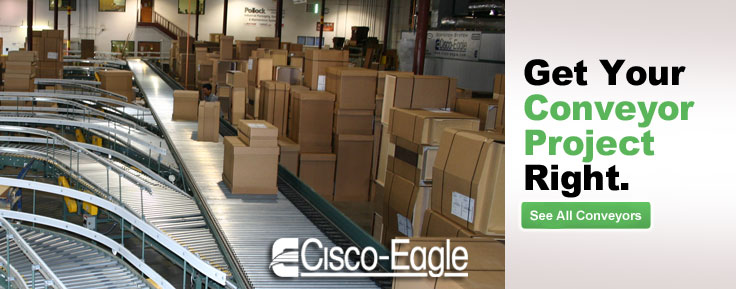A Guide to Gravity Conveyors
How to specify, operate and maintain gravity conveyors
Request Info
The basic gravity conveyor types are skatewheel and roller. There are also flexible variations of these conveyor types.
What is a gravity conveyor?
A gravity conveyor moves the load without utilizing motor power sources, usually down an incline or through a person pushing the load along a flat conveyor. A gravity conveyor can utilize skatewheels or full rollers.
Skatewheel Conveyor:

Roller Conveyor:

The wheels or rollers are built into channel frames held together with "bed spacers." Different widths can be made. Frames can be either steel or aluminum.

Skatewheel Conveyors
Gravity flow skate wheel conveyor is an economical option for conveying lightweight cartons, trays, or totes. Used extensively in shipping/receiving and assembly areas, skate wheel conveyors reduce manual material handling of lightweight items over short distances. It can be useful in elaborate configurations and flow systems as well as smaller, standalone applications.

Above: Wheels are put on axles. Aluminum spacer tubes are put on the axle between the wheels. This keeps wheels from moving from side to side on the axle.

In the drawing above, the axles are on 3 in. centers (also available in 1-1/2 in. centers). The number of wheels on each axle can vary. This determines the number of wheels per foot on the conveyor.
Below: there should always be a minimum of 10 wheels under a box.

Gravity Roller Conveyors
The places you use gravity roller conveyor are mostly the same as skatewheel, with some significant differences in the type of load - see below. Roller conveyor is more expensive than skatewheel, and can be more effective, dependent on what's being moved.

Above: Rollers have their own axles. Most axles are spring-loaded. This means that the axle can easily be moved to one side. (below)

This means that rollers can be easily removed or replaced in conveyor channel frame. The spring also keeps the roller in place. (see below):

Rollers are put into frames as close together or as far apart as necessary for the load and application, but there should be a minimum of 3 rollers under any box being conveyed.

Less than 3 rollers, and a box will tumble:

Determine the roller centers (the distance between centers of your rollers) by the width of the box being conveyed:

Move these items on skatewheel conveyors:
Any items with a smooth, flat bottom. These items can be wider than the conveyor; 6" over on each side is not too much. Extra wide items like plywood, can be moved but must be centered carefully.

Move these items on roller conveyors:
Items with an uneven or open bottom, or with a rim on the bottom should be conveyed on rollers. These items should never be bigger around than the rollers are long.

How Gravity Conveyors are set up:
All sections have couplings:

Above: portable type; below: permanent type.

Support Types:
Portable set-up utilizes tripod stands
Adjustable Tripod Stands are used with straight or curved sections of gravity skatewheel and 1-3/8" dia. roller conveyor. Height is adjustable through a locking screw that puts tension against the inside support rod. Such a system prevents shock loading and limits the conveyor to 350 lbs. capacity. Height is measured to top of roller or wheels.

Permanent setup uses stationary supports
Permanent supports are anchored to the floor to support an entire conveyor line. They can be placed at 5' or 10' intervals, depending on the conveyor. They come in various capacities and height/width configurations.

Powered and gravity conveyors can be used together. This can be an energy-saving strategy. It's often called a "Flow System"





